Hirokos Blog
 Hiroko’s Kitchen made it onto CulinaryPrograms.net’s recently completed list of 100 Magnificent Sites for Chefs.
Hiroko’s Kitchen made it onto CulinaryPrograms.net’s recently completed list of 100 Magnificent Sites for Chefs.
CulinaryPrograms.net says, “We built the list for the next generation of chefs who will soon be entering culinary programs and will need to stay up to date on the latest trends in cuisine, and know how to leverage the internet and other forms of media to get their work noticed. We think your site is a great example of how culinary professionals can use the web to their advantage.”
Posted
on 11:31 AM
in Hiroko's Blog
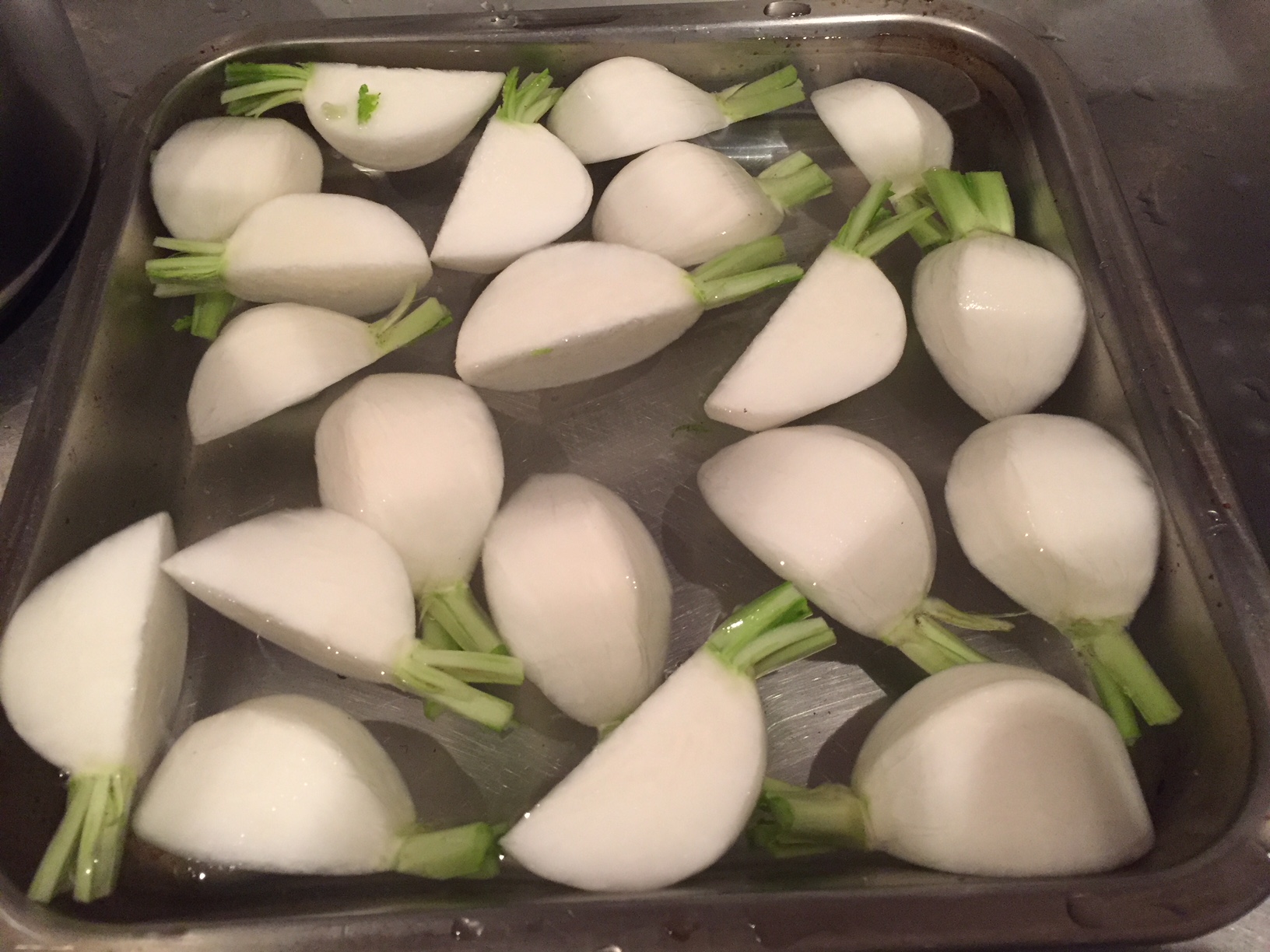
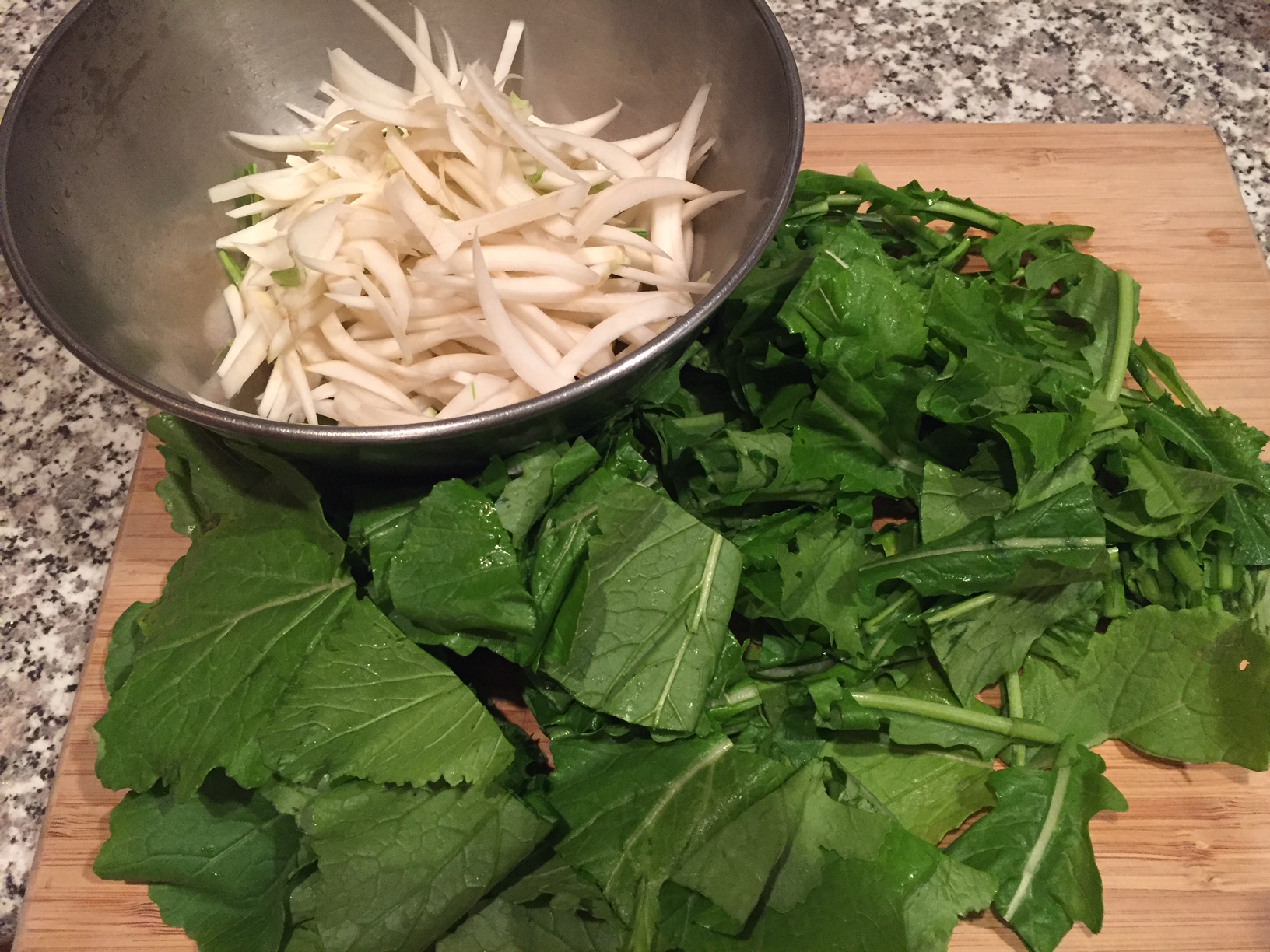

Kieth Farm’s Japanese Hakurei turnips sold by the farm itself at the Union Square Green Market in New York City are the very best quality turnips I know of. The flesh is smooth, juicy and is never rough or stringy. I buy one or two bunches (usually 5 medium bulbs with leaves in a bunch) every week for a traditional simmering dish and as part of a quick salad.
I cook turnips in a traditional way that will be of interest to you. By cooking the turnips in this way we can taste the ‘true’ flavor of the turnips.
Peel the bulbs removing the thick skin, reserving the skin for Kinpira dish (see my previous blog). When peeling, make the bulb into a hexagonal shape. Then cut each turnip into quarter wedges lengthwise. The wedges will have attractive surfaces because of the previous hexagonal preparation. Place the turnips and water in a pot and bring it to a simmer. Cook the turnips for about 4 minutes or until it is firm-tender. With a slotted spoon transfer the cooked turnips to an ice cold water bath to stop cooking. When the pieces are cold rinse them in the new water to remove any harshness. Prepare the turnips marinating liquid – a mixture of dashi, usukuchi shoyu (light color shoyu) and sea salt. Transfer the cooled and rinsed turnip to a new pot of simmering water to warm them up. Gently remove the turnip from the water, drain and add it to the prepared flavored dashi stock.
QUESTION for you: Why do we plunge the cooled turnips in simmering water to warm them before adding them in the heated flavored dashi? Why don’t we simply add the cold, rinsed turnips directly to the simmering flavored dashi stock?
Send your answer to me at hiroko@hirokoskitchen.com by December 4th. The first person who gave me the correct answer will receive a small gift from Hiroko’s Kitchen. I will announce it in the future blog.
hirokoshimbo
Posted
on 11:16 AM
in Hiroko's Blog
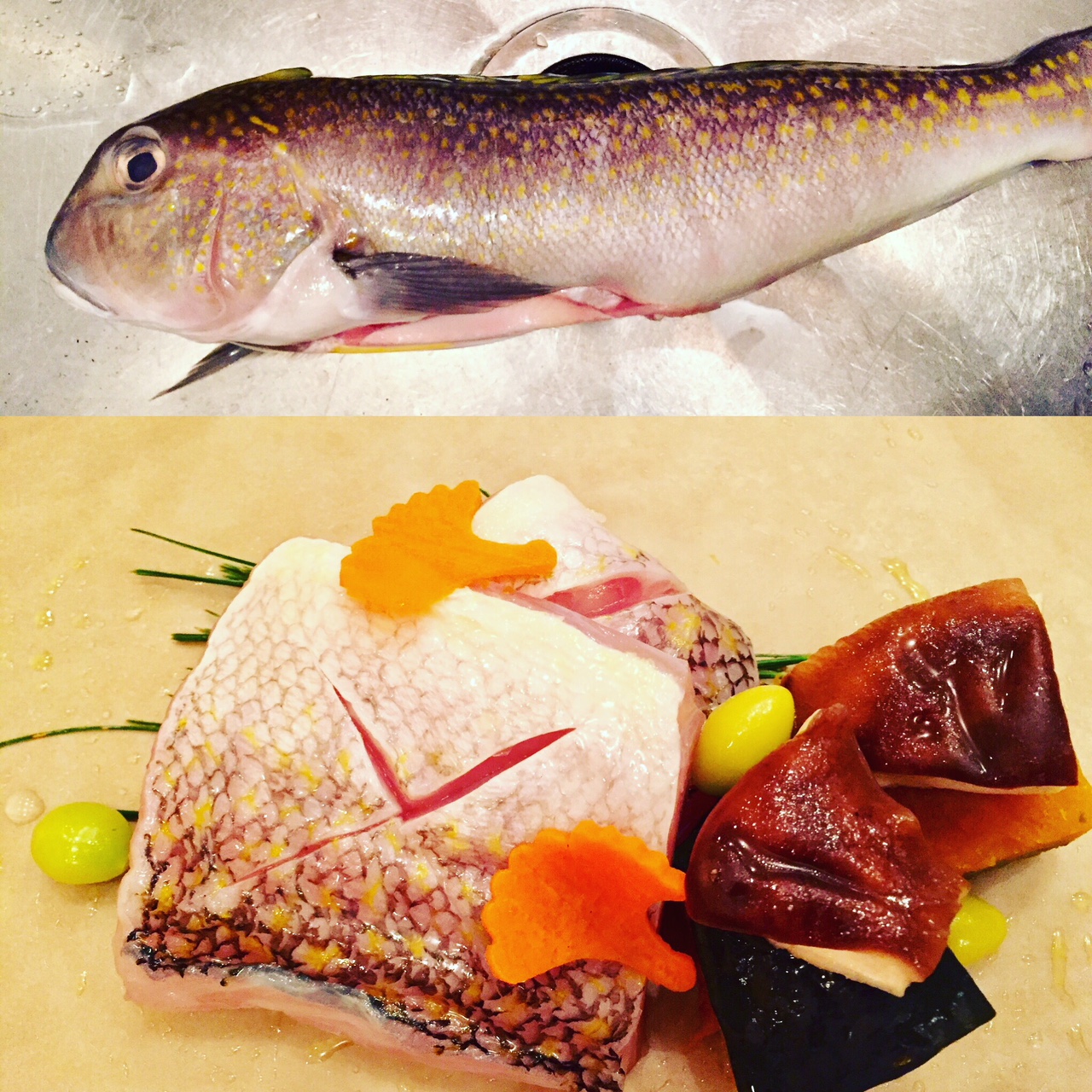
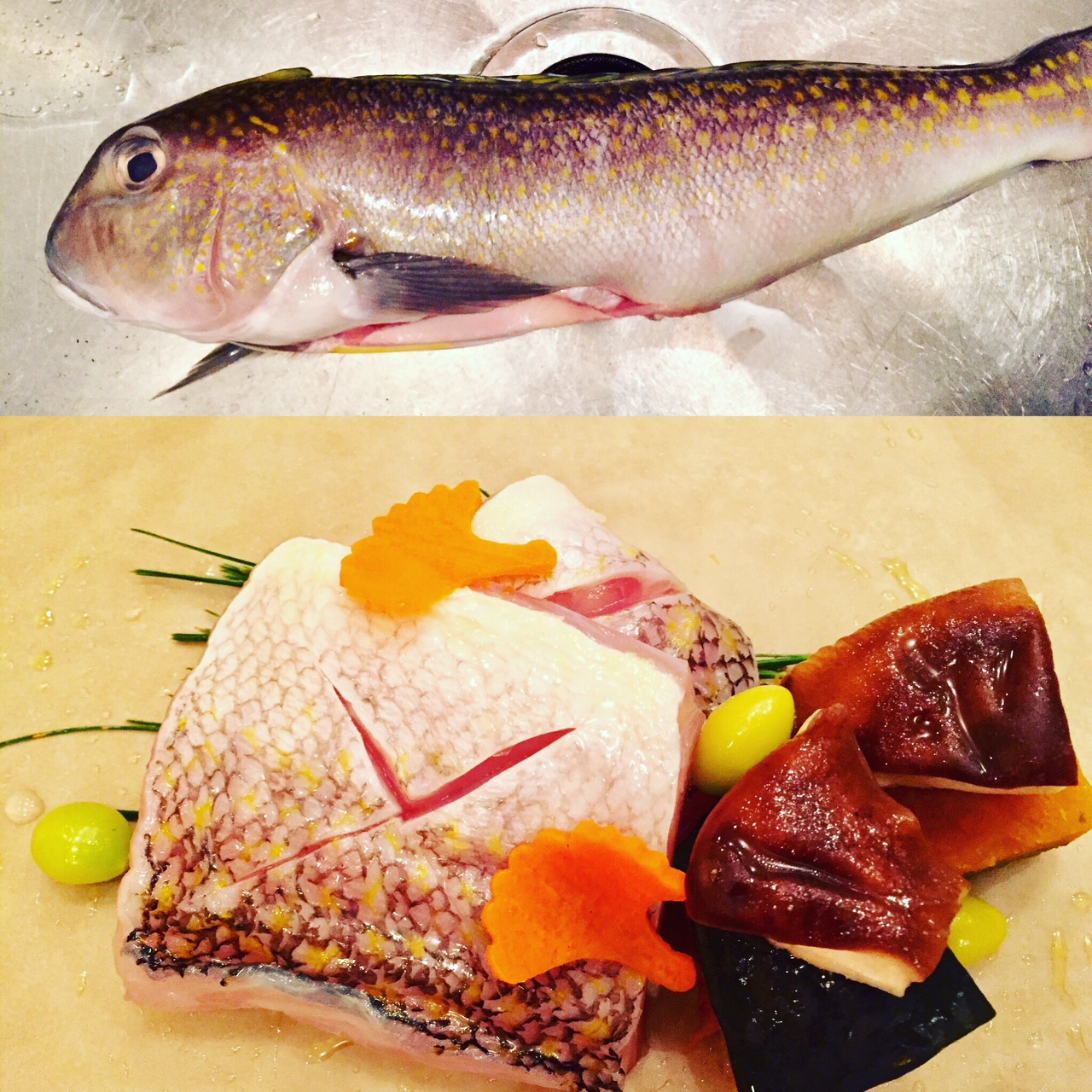

I foraged for pine needles in upstate New York two weeks ago to try a delightful, traditional autumn dish: Matsuba-yaki. Matsuba-yaki is a dish in which seafood and/or mushrooms and vegetables such as Matsutake mushrooms are placed on fresh pine needles and cooked together in a stove-top pot or in the oven.
It is a fundamental principle that Japanese cuisine respects and honors the seasonal changes in nature. Chefs and home cooks alike try to bridge nature and dining room experiences by numerous methods. In addition to the use of seasonal ingredients, chefs utilize materials from nature such as leaves, wood, and pine needles as part of the cooking tools during dish preparation. These natural objects along with edible flowers are also utilized to garnish the prepared dishes and/or to decorate the dining room.
My Matsuba-yaki dish ingredients consist of locally-caught tile fish from the Blue Moon fisherman who sells exclusively at the Green Markets of New York City, gingko nuts foraged from trees on city streets near my home in New York City, and kabocha squash, shiitake mushrooms and carrots all from local farms within a 250 mile radius of New York City. Individually prepped items including the pine needles are wrapped together in parchment paper and baked in the oven. The climax comes at the dinner table, when subtle but distinctive fragrance of pine needles mixed with sweet fish aromas hits our nose. It is wonderful, once again to be in the beautiful and delicious autumn time!
hirokoshimbo
Save
Save
Posted
on 11:15 AM
in Hiroko's Blog
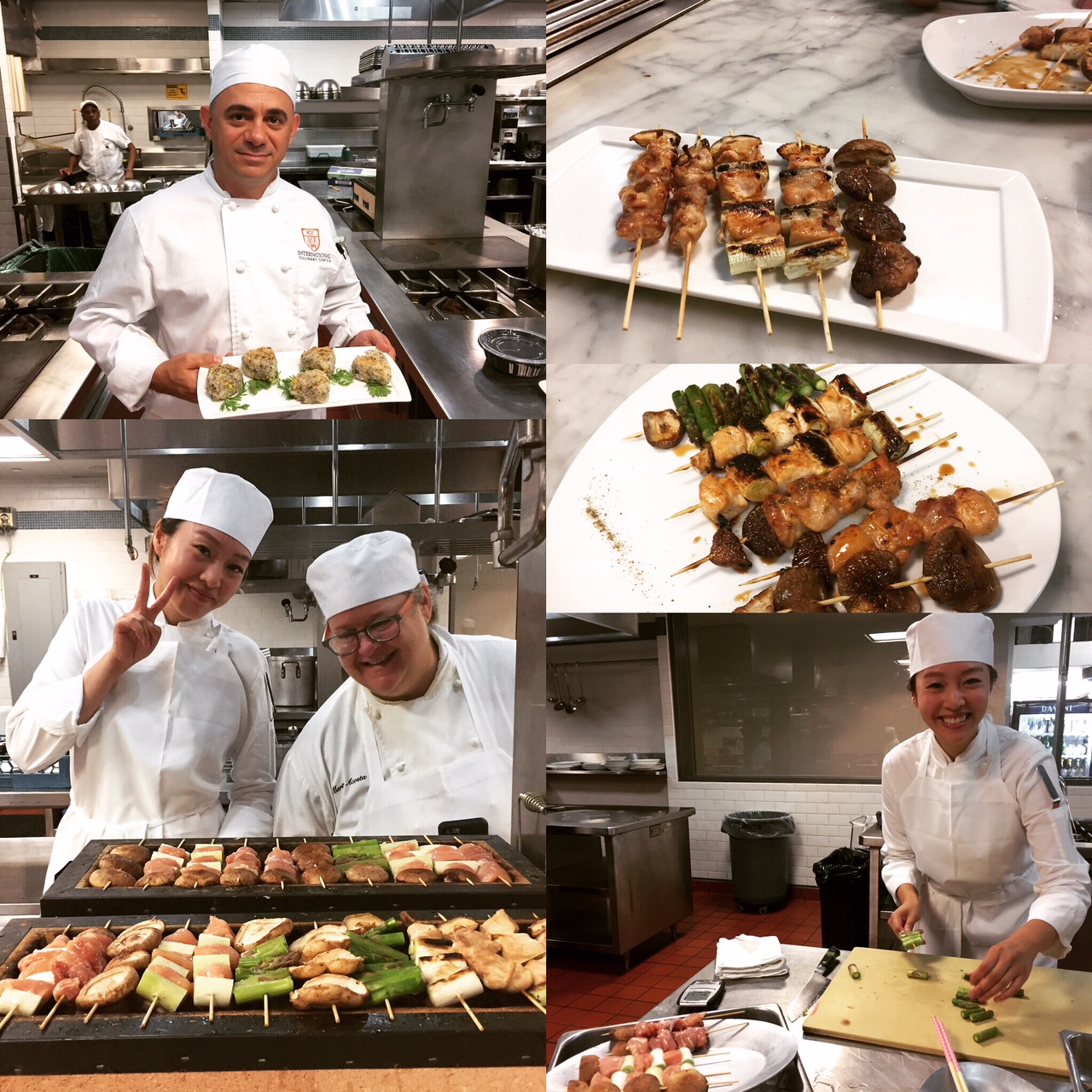
Did you follow my cooking class photos on Instagram? Join me to find the deliciousness, healthfulness, wellness promoting and the enjoyment and happiness of Japanese cooking in 2018:
Here are the Japanese cooking classes and courses that I am will teach in 2018 at the International Culinary Center in New York City.
- Essentials of Japanese Cooking April 9, 10, 11, 12, 13 5:45pm – 10:45pm
- Essentials of Japanese Cooking September 10, 11, 12, 13, 14 9:30am – 2:30pm
- Ramen & Gyoza with Hiroko Shimbo April 19 5:45pm – 9:45pm
- Basics of Sushi with Hiroko Shimbo July 19 5:45pm – 9:45pm
Japanese cuisine is delighted to be part of your daily life! It brings health, wellness, happiness and fun to your life. At my classes you will learn the basics, philosophy and delicious preparations of wonderful classic Japanese dishes. Whichever class or classes you choose to attend will enrich your life in 2018.
Essentials of Japanese Cooking Course (see the Instagram photos of students cooking and learning a great deal at this course @hirokoshimbo) is a five day intensive Japanese cooking classes for those – both avocational and professional – who wants to discover, learn and enjoy Japanese cooking including its history, philosophy, ingredients, presentation and preparations. You will learn many dishes will surely become your favorites, and the favorites of those who enjoy your cooking. What you will learn can be used in for frequent daily meals with your family and friends, as well as for special occasions.
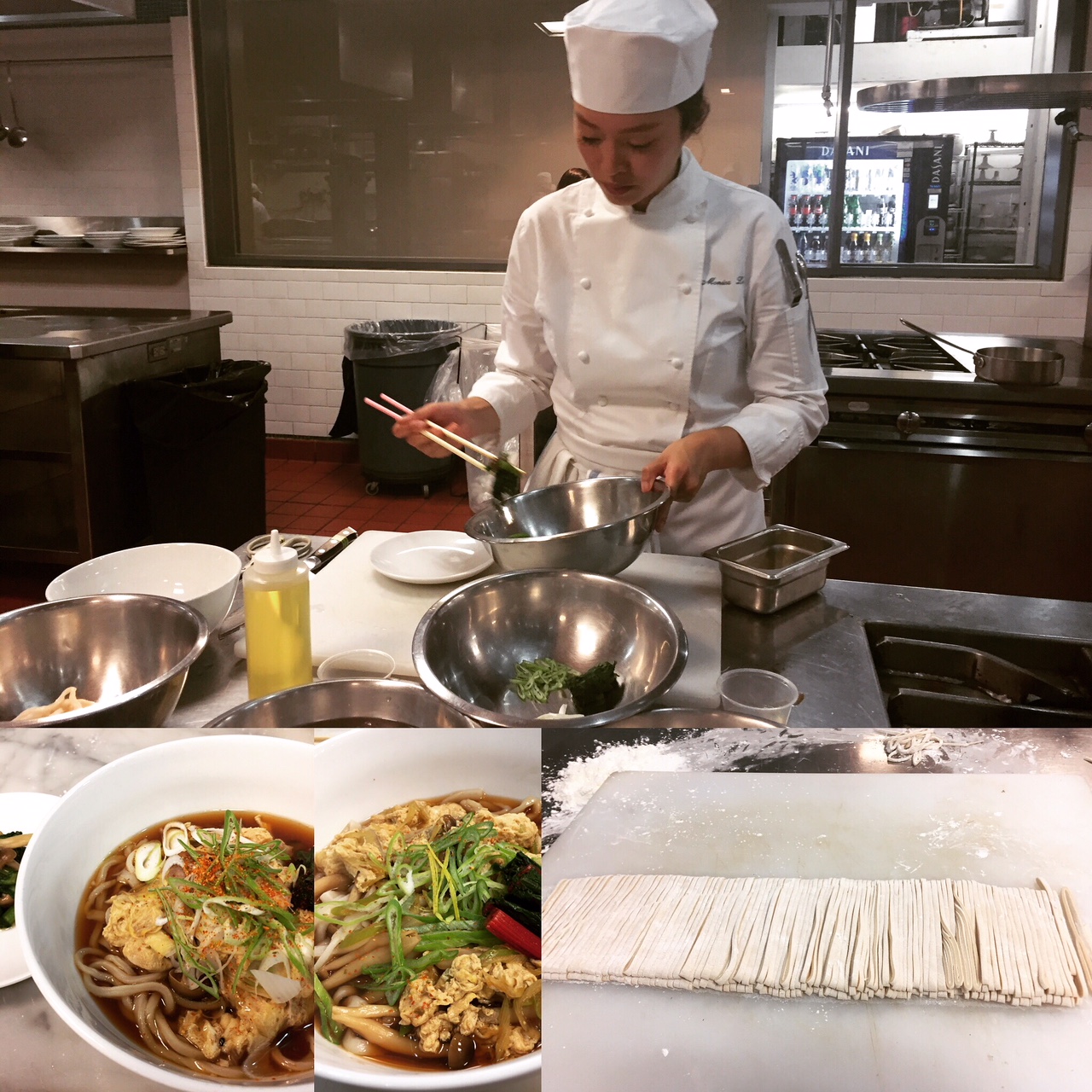

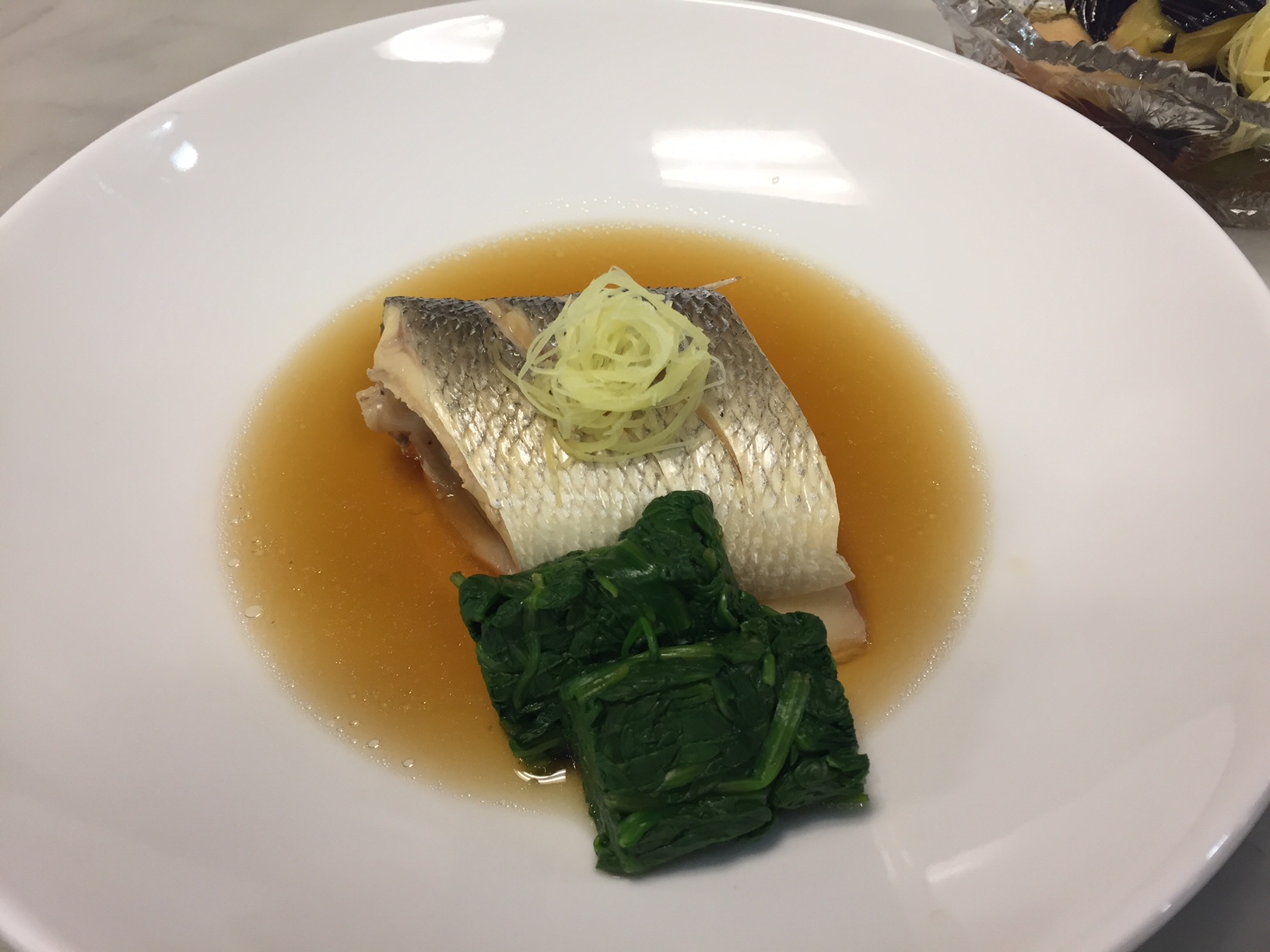
Ramen & Gyoza with Hiroko Shimbo is a one day class dedicated to those who love to slurp ramen noodle soup and want to know how to reproduce this classic in your own kitchen. You will learn the history, ingredients and preparations of ramen, including hand-making the ramen noodles themselves. Every ramen restaurant always offers gyoza dumplings. At the class you will also learn how to make classic pork and cabbage gyoza dumplings. Prepare ramen and gyoza with your friends and family. It will become a loved tradition in your in your kitchen!

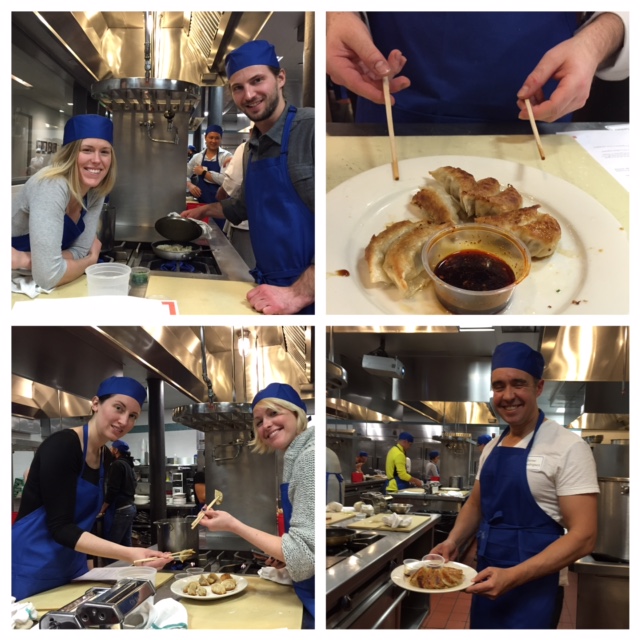
Basics of Sushi with Hiroko Shimbo is a one day class for those who want to learn the basics of sushi preparation – perfect sushi rice, tangy pickled ginger, sweet rolled tamago omelet, simmered shiitake mushroom and special sushi shoyu dipping sauce. Using the these ingredients you will learn how to make your favorite maki-style rolls – thin roll, thick roll and inside-out roll. You can begin a monthly maki night tradition for friends and family at your own kitchen. Bring your fellow diners in on the fun, by showing them what you have learned from Hiroko and inviting them to make maki, too.
Contact Hiroko @212-727-3085 if you have any questions.
hirokoshimbo
Save
Posted
on 7:33 AM
in Hiroko's Blog

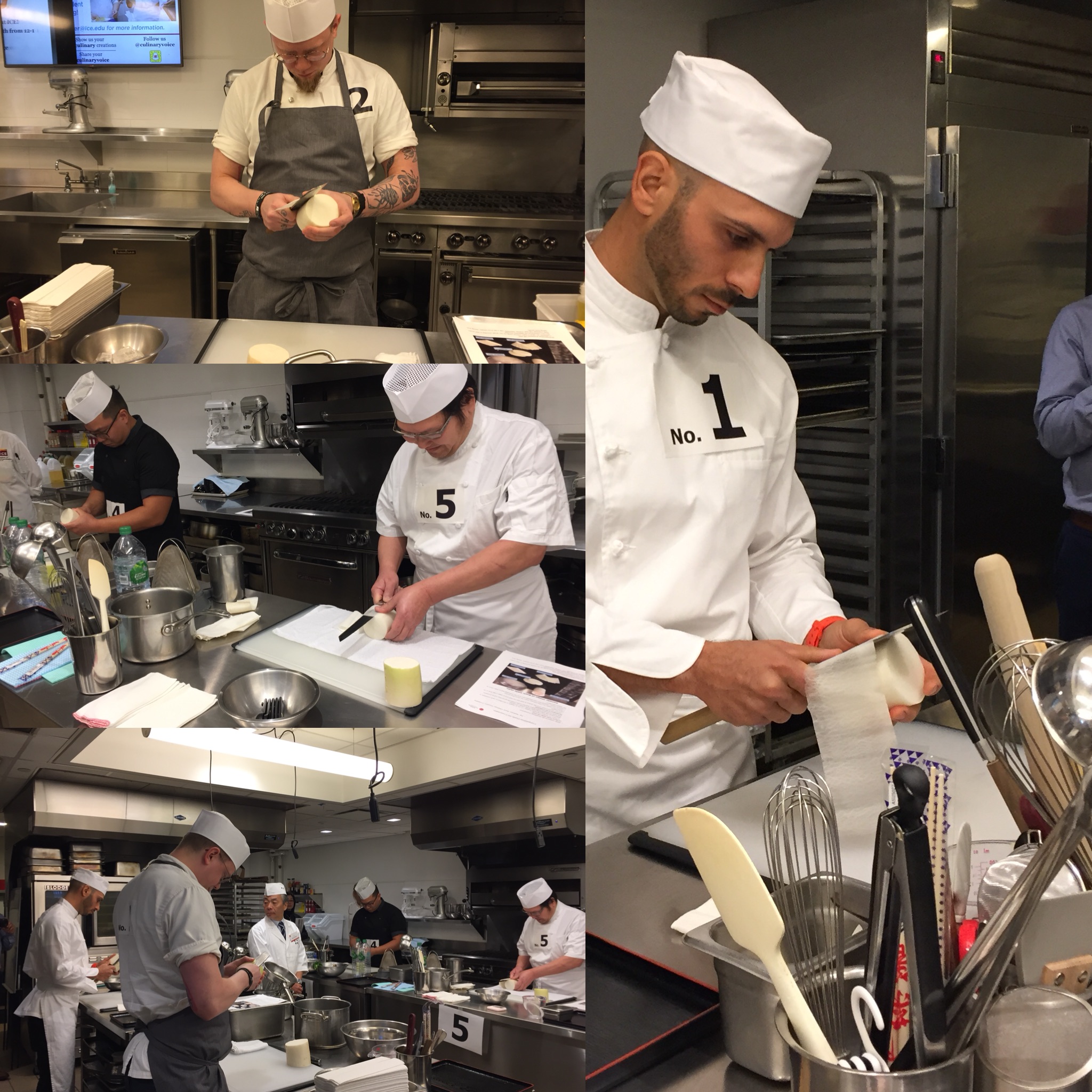
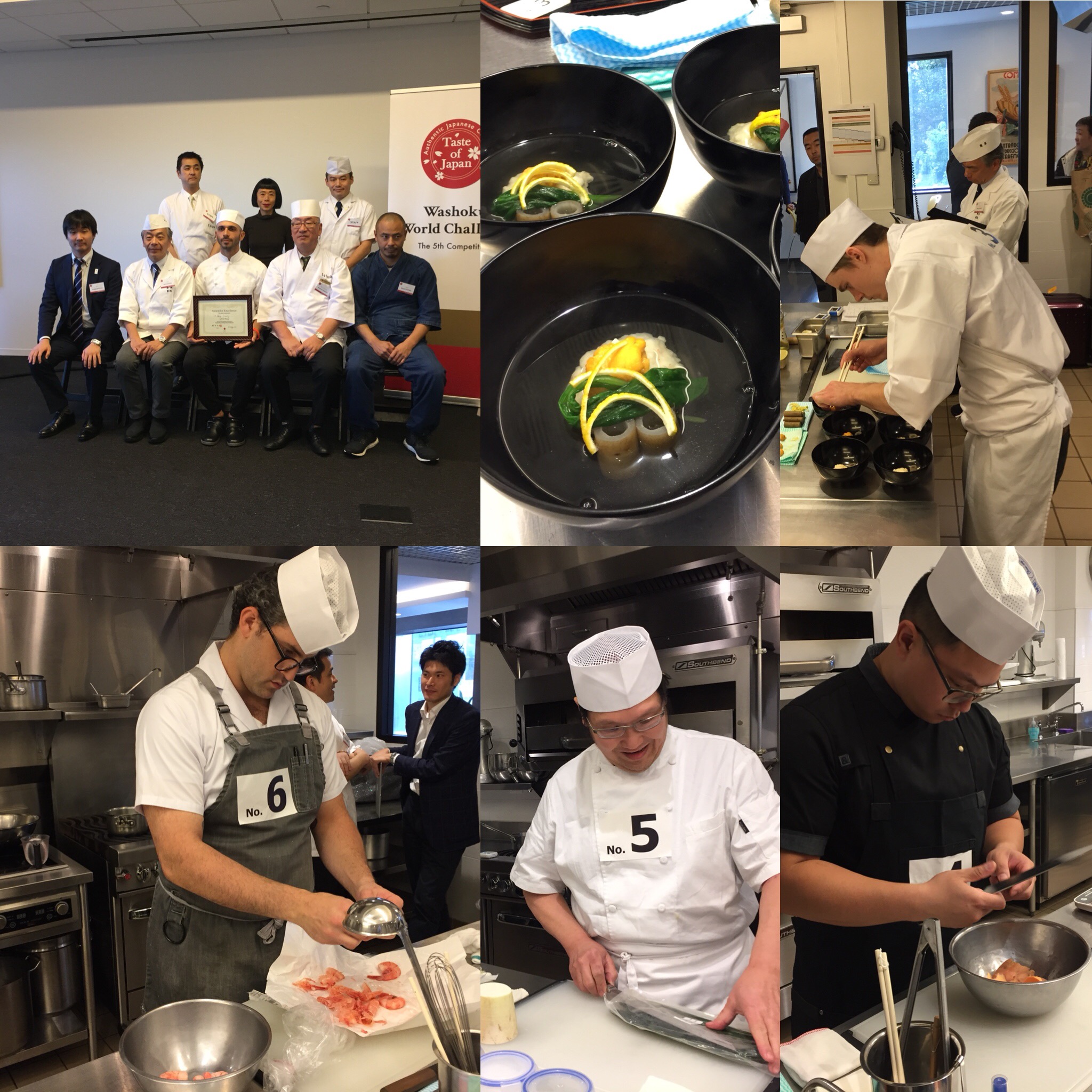
Oh, Boy! What fruitful and successful separate Japanese cuisine competitions, sponsored by two different Japanese entities, were held here in New York on October 29th and 30th, 2017.
The winners of the both New York Pre-Competitions are invited to compete in final rounds in Japan, and the winners of those competitions in Japan receive a monetary award as well as broad recognition in the US and Japan of their skills and accomplishments. Please check-out my Instagram photos (@hirokoshimbo) of the recent Pre-Competitions. If you missed participating in these exciting Pre-Competitions as a participant chef, the photos will help you understand these events. Please do not fail to apply for these competitions when they return to New York City in the next and following years. Let me know of your interest and I will keep you posted.
These Pre-Competitions are held for non-Japanese citizens who are working as chefs at restaurants producing Japanese cuisine or those who are pursuing an in-depth knowledge of Japanese cooking for its own sake. If you believe you qualify and wish to participate, please send me your name and contact info. I will keep you on the list for contact and send you the next competitions’ information when they are available.
Today the number of restaurants producing Japanese cuisine outside Japan has reached more than 85,000. In 2015 Japanese cuisine was designated as a UNESCO Intangible Cultural Heritage. Japanese cuisine is now enjoying great popularity. I and the operators of these competitions believe that this worldwide popularity owes its status to hardworking chefs at Japanese restaurants all over the world. The organizations who sponsor these competitions, sincerely thank all of YOU.
The two competitions are:
- Japan Culinary Arts Competition (JCAC)
Japan Culinary Arts Competition is organized by NPO Japanese Culinary Academy (the Japanese equivalent of the James Beard Foundation in the US). The purpose of this competition is to offer chefs like you a chance to demonstrate the true depth of your knowledge and skills in the preparation of Japanese cuisine. The winner of the New York Pre-Competition is invited to Japan (expenses paid) the following March to compete at the Final Competition. Fourteen Pre-Competition winners will compete in the Final Competition.. The next round Pre- Competition will be held in 2019 in New York
The winner of JCAC New York Pre-Competition this year, 2017 is Marc Spitzer, Executive Chef of BondST in New York City
- Washoku World Challenge (WWC)
Washoku World Challenge is sponsored and organized by Japan Ministry of Agriculture, Forestry and Fisheries. The purpose of WWC is to nurture the knowledge and cooking skills for producing excellent Japanese cuisine outside of Japan. The competition offers an opportunity for you demonstrate your passion, knowledge and skills. This leads to a better world-wide understanding of Japanese cuisine and its required cooking skills. The winner of this New York Pre-Competition is invited (expenses paid) to Japan early the next year for the Final Competition. The winner of the New York Pre-Competition is invited to Japan (expenses paid) early the following year following to compete at the Final Competition. For the recent Pre-Competition, the final round will take place this February in Kyoto, Japan among the six Pre-Competition winners. The next round Pre-Competition will be held in New York in 2018
The winner of WWC Pre-Competition this year, 2017 is David Israelow, a catering chef based in New York City.
Stay tuned for future information!
hirokoshimbo
Save
Save
Save
Posted
on 8:25 PM
in Hiroko's Blog
 When something is delicious it is hard for us to stop eating. When it comes to gingko nuts, we should limit consumption to about ten nuts at a sitting. Over-eating can bring a reaction to methyl pyridoxine, a chemical found in the nuts. This can cause a stomach ache and, in extreme, vomiting. On other hand, gingko nuts has been used as a constituent of Chinese medicine to cure some illness for centuries, so limiting to about ten nuts a day seems to be a good idea. This way you can enjoy the delicious flavor without risking stomach distress.
When something is delicious it is hard for us to stop eating. When it comes to gingko nuts, we should limit consumption to about ten nuts at a sitting. Over-eating can bring a reaction to methyl pyridoxine, a chemical found in the nuts. This can cause a stomach ache and, in extreme, vomiting. On other hand, gingko nuts has been used as a constituent of Chinese medicine to cure some illness for centuries, so limiting to about ten nuts a day seems to be a good idea. This way you can enjoy the delicious flavor without risking stomach distress.
When you break the shell to reveal the inside nuts – there is a special tool to do it (see the photo) – a whitish beige nuts appears. When you cook the nuts they turn bright, deep green color in few minutes. The texture of cooked nuts is slight soft and the flavor, sweet-nutty and pleasantly bitter. Have you ever tasted gingko nuts? This is the season to try it!
Here are two ways to cook them:
- Salt roasting: In this preparation half-shelled nuts are cooked in salt added skillet (no oil), leaving thin skin of the nuts attached to the surface of the nuts.
- Crack the nuts with the tool and break off the top half of the shell, exposing the top half part of the nuts with thin skin, discarding the removed shells.
- Heat the skillet (no oil) with some salt. When the salt is heated, add the nuts and cook, shaking the skillet from time to time and rolling the nuts over. When the exposed part of the nuts turns deep, bright green, turn off the heat. Serve them as they are with a glass of beer!
- Boiling: In this preparation fully shelled nuts are cooked in salted water that removes the thin skins attached to the nuts
- Crack the nuts with a tool and remove the nuts from the shells.
- Bring shallow water in a pot to a boil and add the gingko nuts. While cooking the nuts, with a flat spatula gently press and roll the surface of gingko nuts so that the thin skin detaches from the nuts. When the nuts turns deep, bright green, turn off the heat. Drain and rinse the beans, discarding thin skins. Serve them as they are, toss them with cooked rice, or use them as a garnish for prepared dishes.
Remember about ten nuts a day and don’t eat them raw!
hirokoshimbo
Posted
on 7:46 PM
in Hiroko's Blog, Recipes
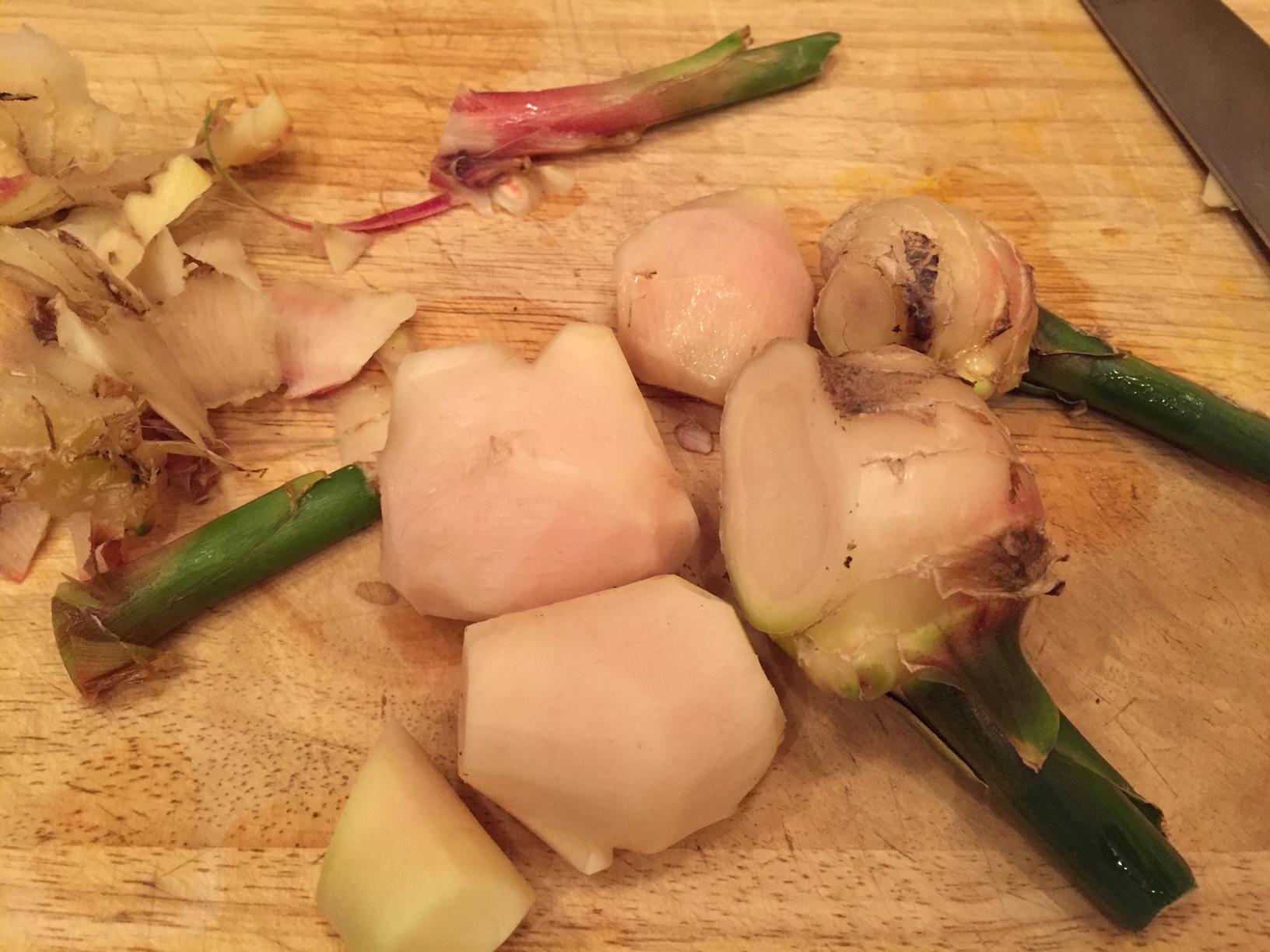
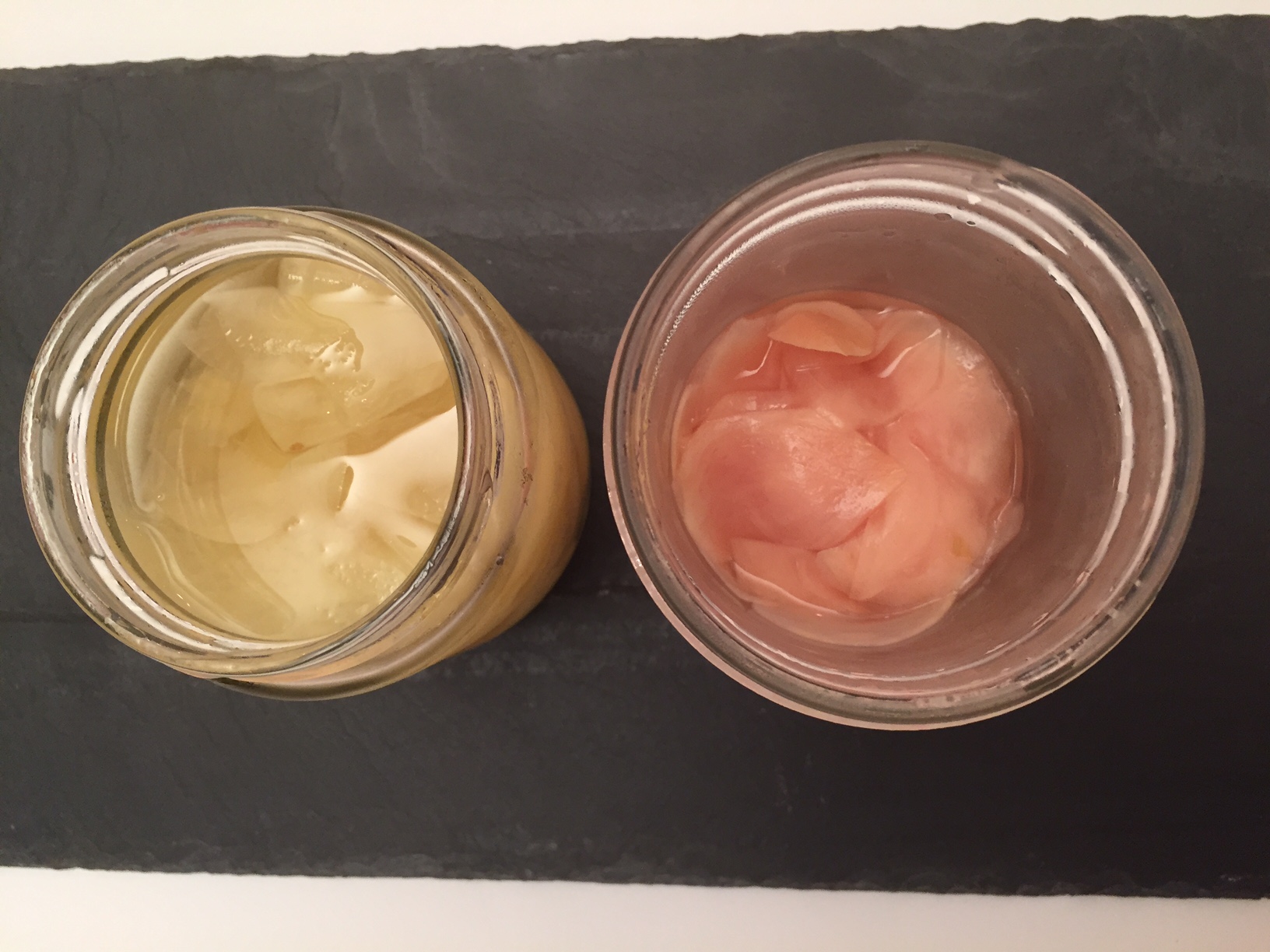
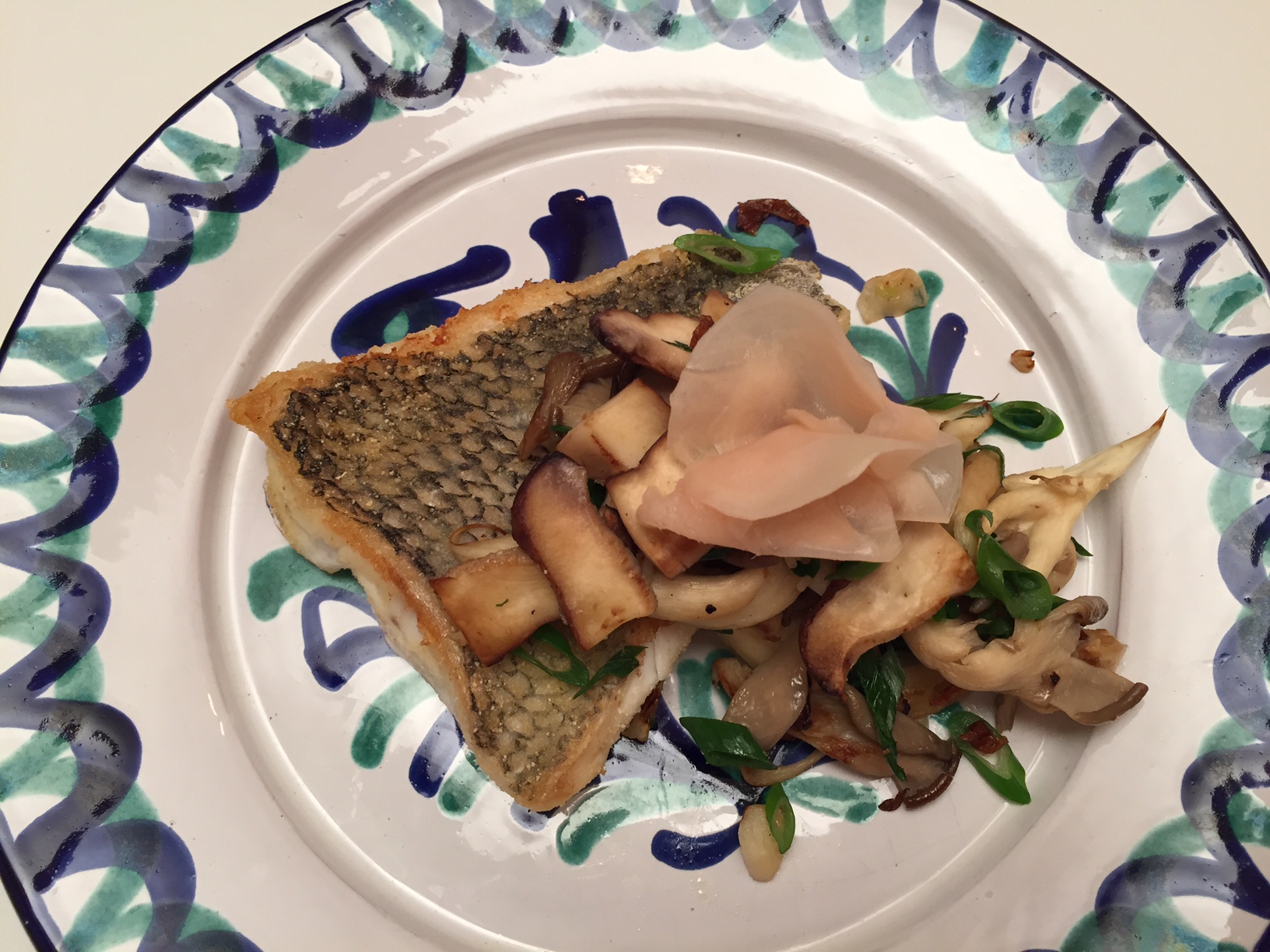 The new ginger season is over….but let me tell you this story before getting too old.
The new ginger season is over….but let me tell you this story before getting too old.
Anthocyanin, color pigment in new ginger reacts with vinegar in the pickling liquid and turns the sliced ginger to petty pink color. No synthetic food coloring is involved. Changing of the color, however, does not happen all the time.
This summer I pickled new ginger roots that came from two different farmers at Union Square Market here in New York. One farmers’ new ginger did not turn pink at all. You can see the color in the photo. With huge disappointment I went on line and searched for the answer to learn why some new ginger doesn’t turn to pink There were not many helpful answers, but it seems that new ginger has to be very fresh. Fresh ginger has higher anthocyanin content than ginger that has been stored for weeks.
Haifa, the wife of organic farmer Zaid grabbed the long stem of new ginger with meaty bulbs and green leaves and handed it to me. The green leaves on the stem and faint pink bulb gave promise to me that this new ginger would definitely turn to pink. The rest is shown in the photo.
Having pickled ginger in the refrigerator is very handy. I always serve grilled fish with handful of pickled ginger. It is a wonderful mouth refresher. If you haven’t made your own pickled ginger, here is the recipe (from my book The Sushi Experience).
¼ cup rice vinegar
2 tablespoons sugar
1 teaspoon sea salt
7 ounces new ginger or old ginger (It won’t turn pink!), peel and cut into thin slices
Bring the rice vinegar, sugar and salt along with 2 tablespoons water to a boil. Dissolve the sugar and salt and turn off the heat. Blanch the ginger slices until the slices are translucent. Drain the ginger and pickle in the prepared pickling juice.
hirokoshimbo
Save
Save
Posted
on 5:33 PM
in Hiroko's Blog
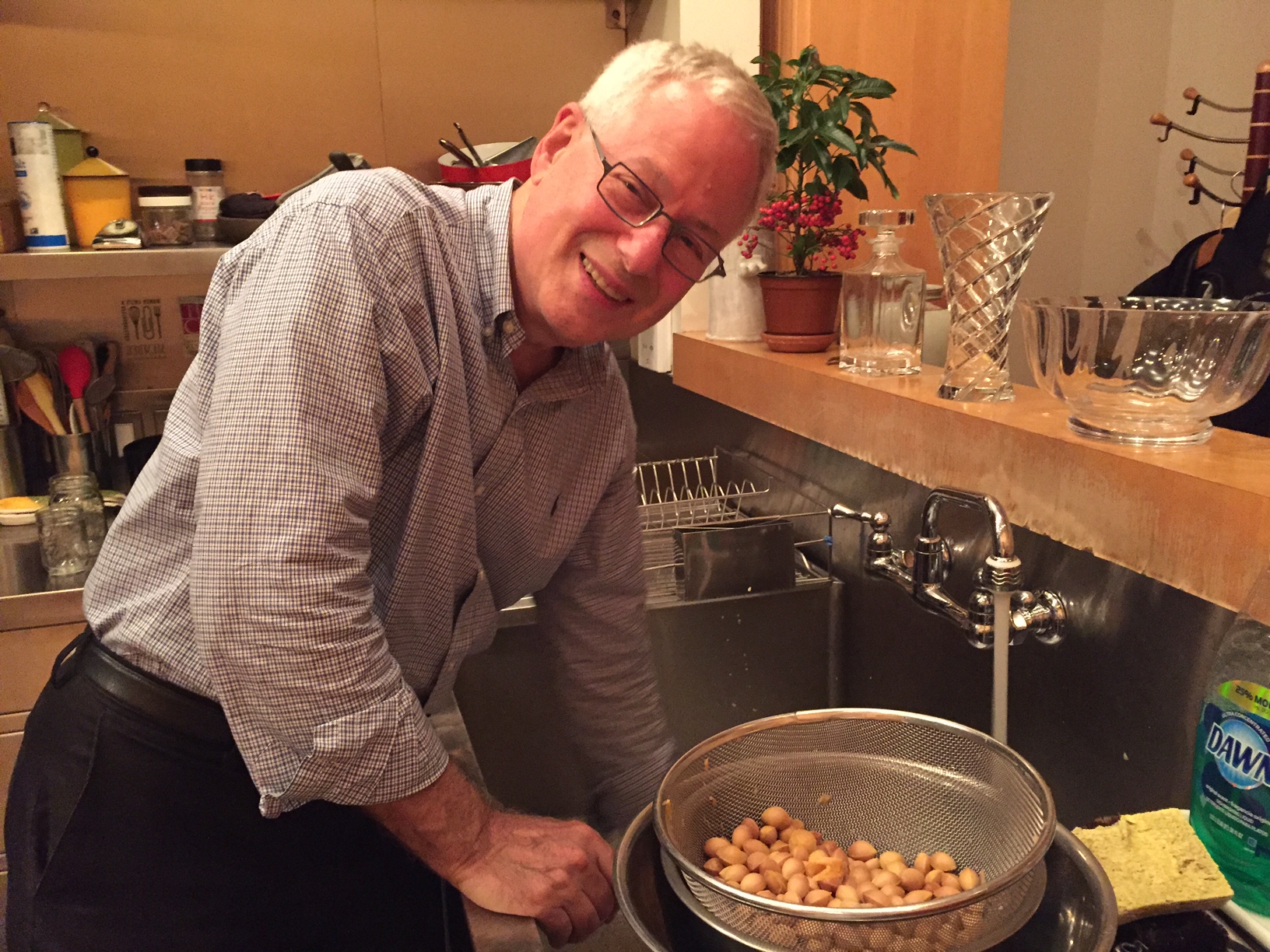
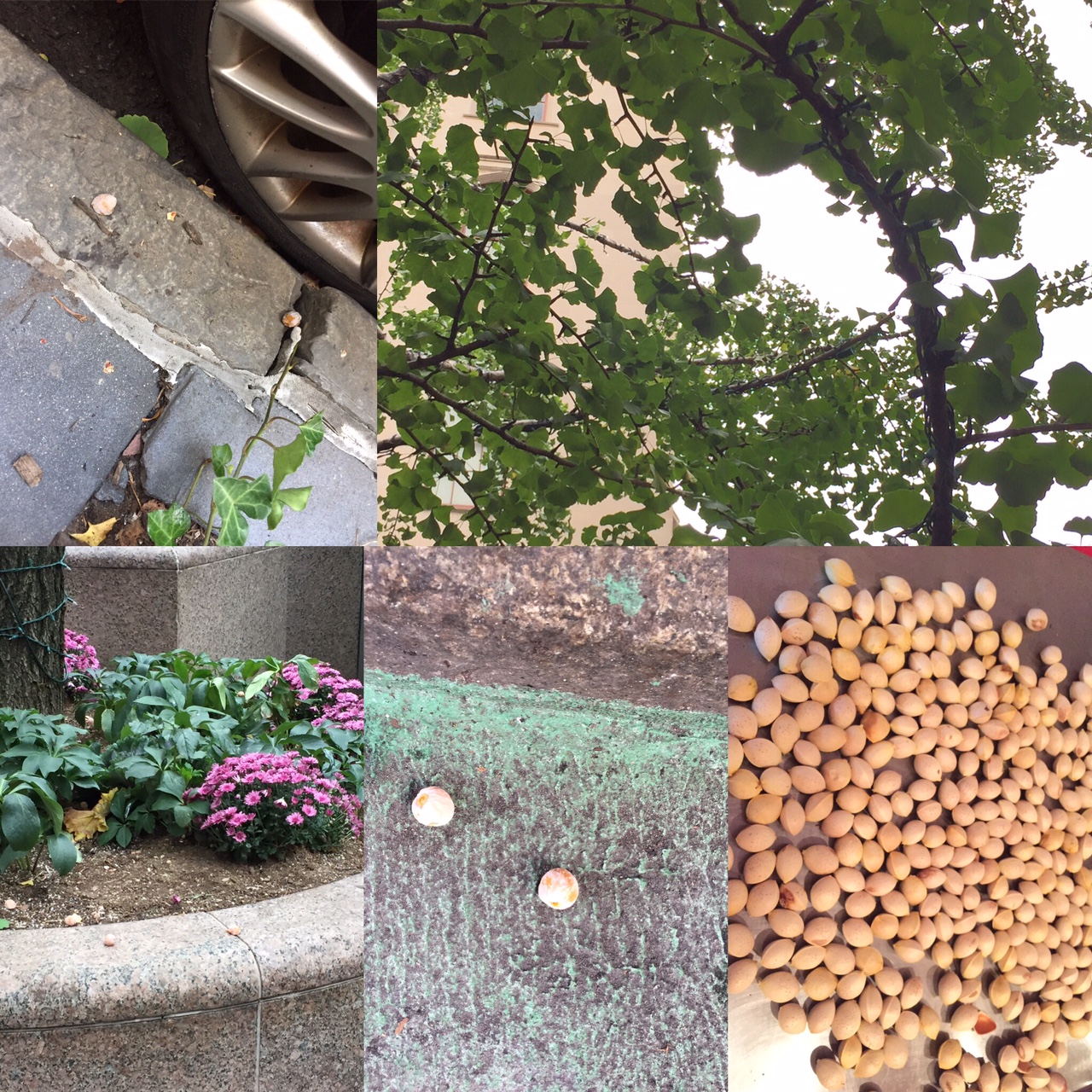
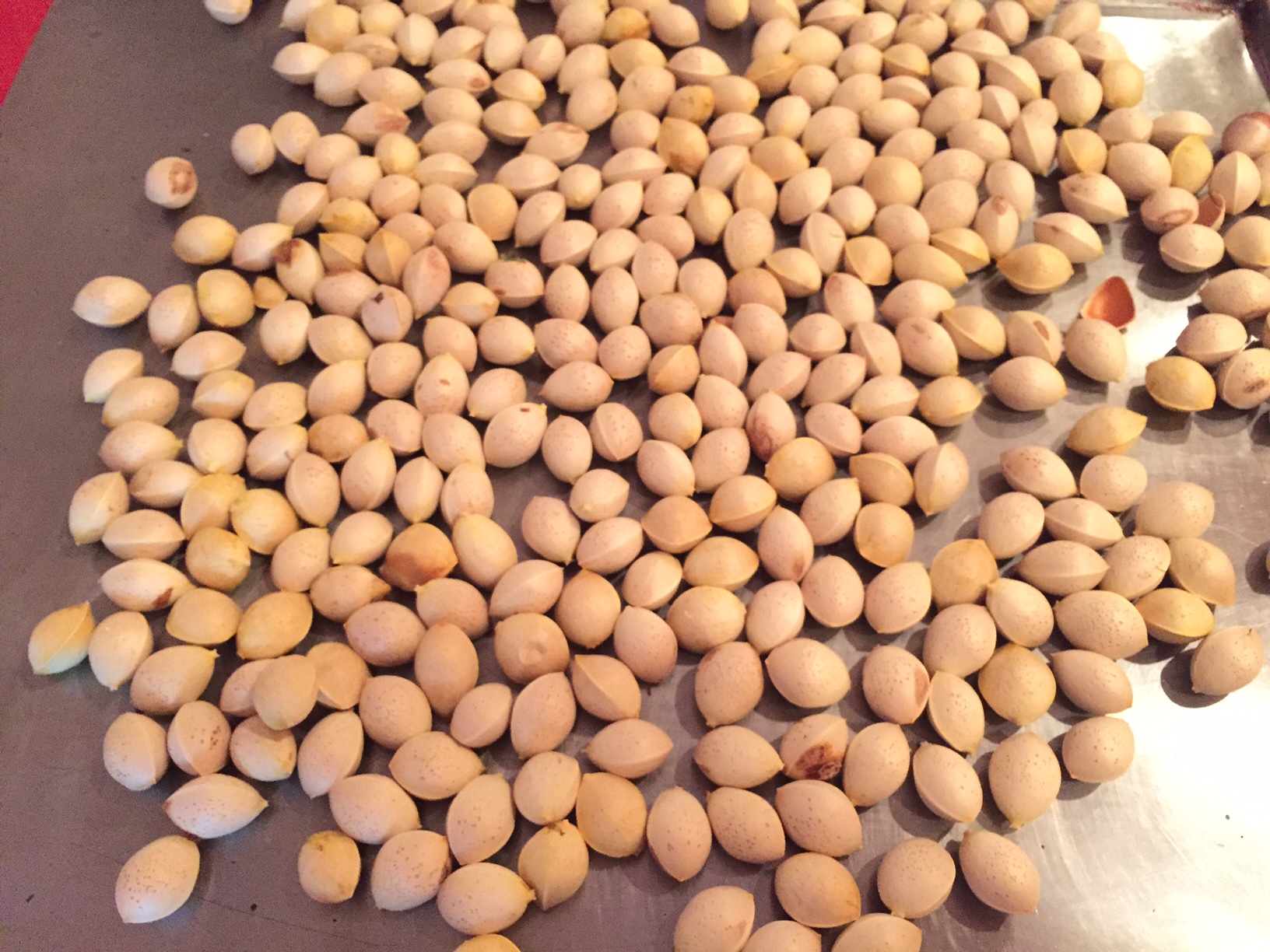 At this time of the year when you stroll in New York City something smells. It is not a smell of pizza or stir-frying foods from the food vendors. It is not the regular New York garbage smell on days when garbage is put out for collection. It is a seasonal smell. The smell, though, is definitely not nice.
At this time of the year when you stroll in New York City something smells. It is not a smell of pizza or stir-frying foods from the food vendors. It is not the regular New York garbage smell on days when garbage is put out for collection. It is a seasonal smell. The smell, though, is definitely not nice.
This is the very time Buzz rushes out to certain places in our neighborhood with a plastic shopping bag or two in hand. Buzz remembers the location to visit, but mostly the smell leads him to the best spot. When reaching the smell’s epicenter there he finds the treasure he is seeking – lots of gingko nuts dropped on the pavement, street or on the ground in the backyard of buildings. He diligently collects half mashed fruits without wearing mask or gloves and come back to home with a bag full of awfully smelly gingko fruits. I wonder how many people pay attention to him while he is picking up the rotten smelling fruits or carrying a hideously smelly bag to home. After the gingko fruits land in our large kitchen sink, Buzz rinse them and remove all of the stinky outer fruit fresh. Kitchen is full of acid, hideous smell. Buzz does not mind it. He is looking forward to the delicious gingko dishes which I am going to make for the next two weeks or so. I am grateful for Buzz.
The gingko tree is known to withstand pollution and chemicals, and has long been planted in the big cities to offer greenery in the world. Tokyo has many gingko trees and the gingko leaf is the Tokyo City emblem. While I was growing up in Tokyo even though foraging was possible I did not need to take such a step to obtain delicious gingko nuts. When the season arrives in the fall every food store carries gingko nuts, already cleaned and odor-free. In autumn gingko nuts replaces edamame as a beer snack at restaurants.
When gingko fruits mature and drop on the ground, many of them break and release their nasty odor. Every city tries to plant only male gingko trees that do not produce the smelly fruit. This simple task seems to be a difficult one. When the trees are small, it is hard to distinguish which are female and which are male, so the mistake of planting a female nut-producer seems to be about one in ten trees, at least that is the case here in New York. Another problem that I found on my search on line reveals that male gingko tree can changes sex and become a female tree to produce the next generation of trees when the gingko trees faces some natural danger. This is how the gingko tree has been surviving on earth for million years.
In my next blog I will describe how to enjoy these delicious nuts whether or not you forage them yourself.
hirokoshimbo
Save
Save
Posted
on 7:03 AM
in Hiroko's Blog


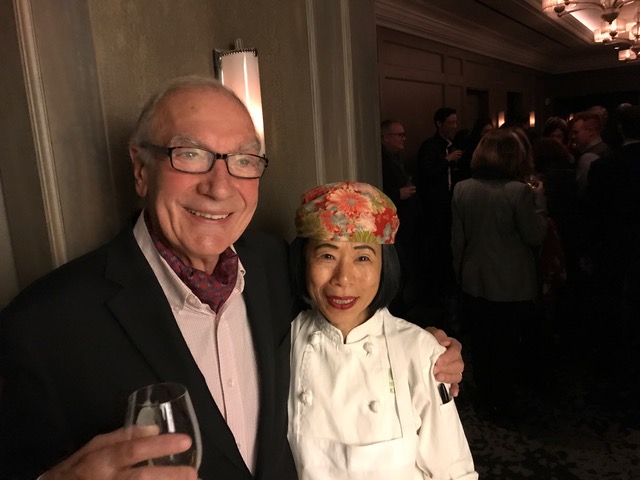
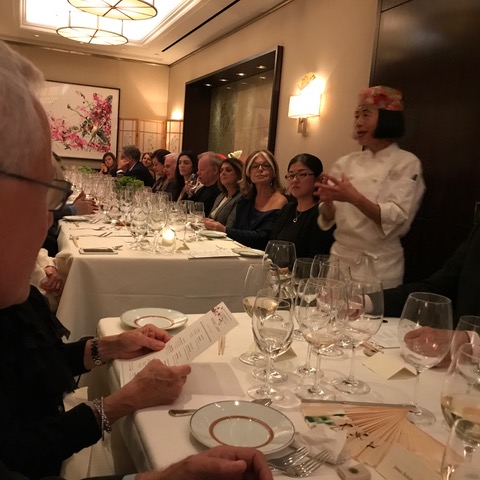 Exploring Japanese cuisine with young, talented and one of the most successful chefs at Café Boulud in New York City in the past weeks and producing the memorable dinner – Voyage to Japan – on October 17th was a dream to come true experience for me. Thanks to all chefs working in the kitchen for your heartfelt welcome and support. Executive Chef Aaron Buldorn made sure that we had terrific ingredients to play with for the dinner from wild Bluefin tuna from Maine, Madai sea bream from Tsukiji Market in Tokyo, Matsutake mushroom from both east and west coast, foraged gingko nuts & pine needles and plump green yuzu. I was too busy to take any photos for these gorgeous ingredients. Sometimes cherishing memories without photos leaves far stronger, sharper image in my mind. hirokoshimbo
Exploring Japanese cuisine with young, talented and one of the most successful chefs at Café Boulud in New York City in the past weeks and producing the memorable dinner – Voyage to Japan – on October 17th was a dream to come true experience for me. Thanks to all chefs working in the kitchen for your heartfelt welcome and support. Executive Chef Aaron Buldorn made sure that we had terrific ingredients to play with for the dinner from wild Bluefin tuna from Maine, Madai sea bream from Tsukiji Market in Tokyo, Matsutake mushroom from both east and west coast, foraged gingko nuts & pine needles and plump green yuzu. I was too busy to take any photos for these gorgeous ingredients. Sometimes cherishing memories without photos leaves far stronger, sharper image in my mind. hirokoshimbo
Save
Posted
on 6:22 AM
in Hiroko's Blog
THANK YOU VERY MUCH for some of the chefs who sent us your resume. Now the position is CLOSED. Wish you all the best!
Hiroko Shimbo
Japanese company which operates a golf course and a sushi restaurant is looking for a talented sushi chef, who can lead the restaurant. The location is Oahu Island, Hawaii.
If any one of sushi chefs are interested in learning more about the job, please contact me. I will connect you to the company.
Thank you,
Hiroko Shimbo hiroko@hirokoskitchen.com 212-727-3085
Posted
on 6:13 AM
in Hiroko's Blog

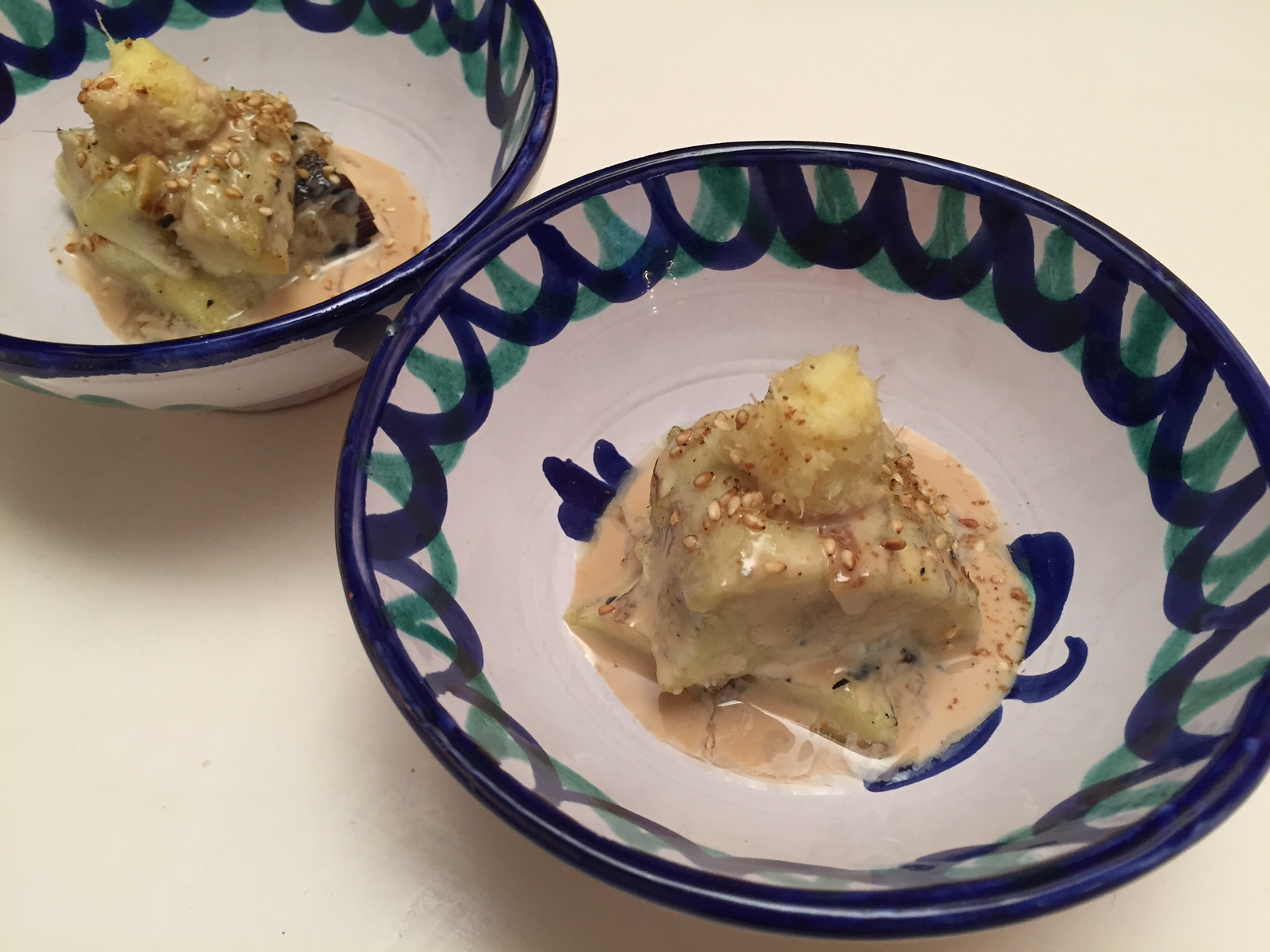
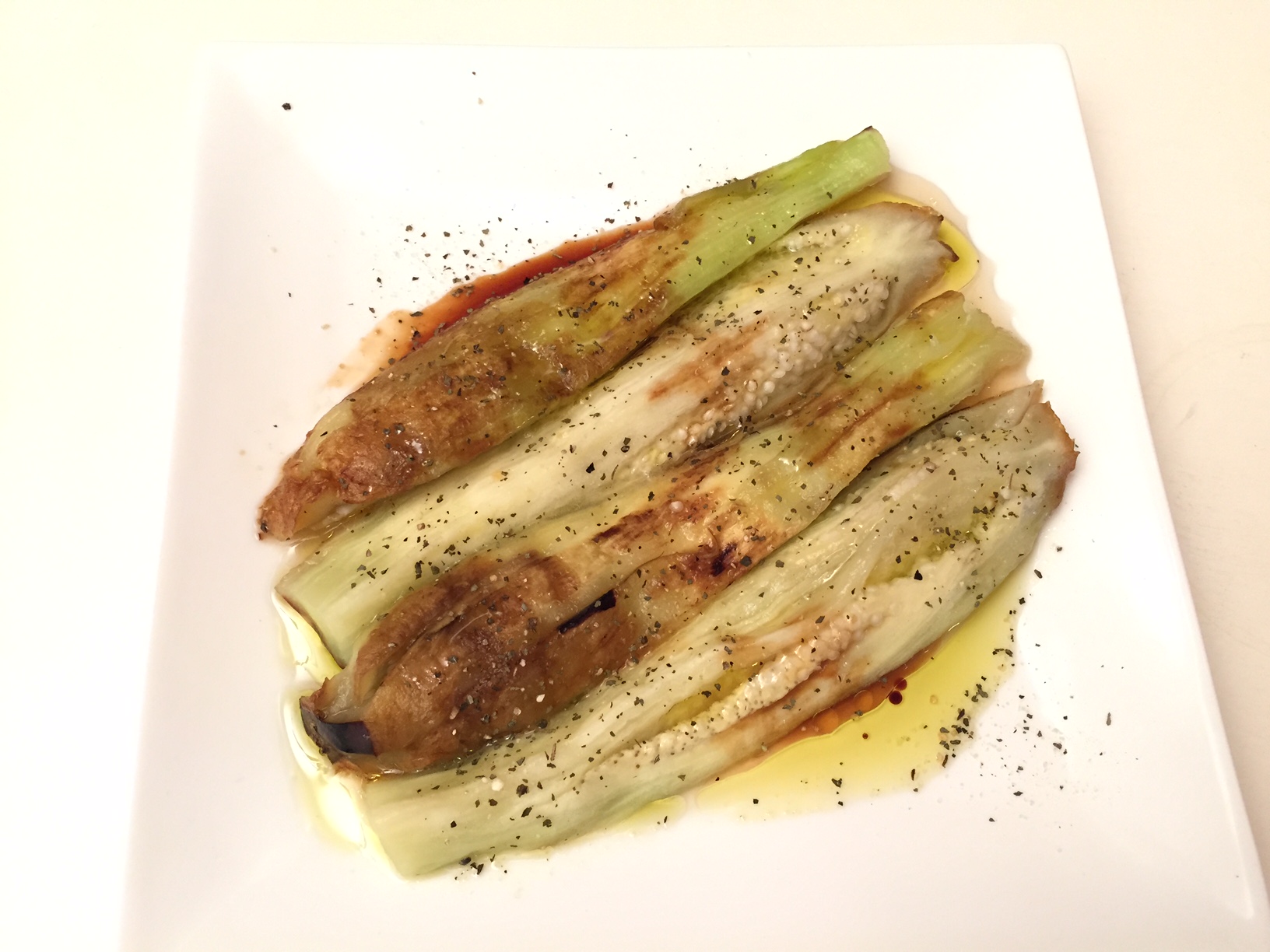 You may be surprised that, if you are given a chance to taste simply grilled eggplant prepared by the Japanese Yakinasu method, how delicious eggplant is. The texture is amazingly creamy; the flavor is a combination of smokiness, natural sweetness and hint of pleasant bitterness. Now we are in the midst of autumn. It is the very best time for you to discover the true flavor of eggplant!
You may be surprised that, if you are given a chance to taste simply grilled eggplant prepared by the Japanese Yakinasu method, how delicious eggplant is. The texture is amazingly creamy; the flavor is a combination of smokiness, natural sweetness and hint of pleasant bitterness. Now we are in the midst of autumn. It is the very best time for you to discover the true flavor of eggplant!
I have posted three short videos related Yakinasu preparation techniques on Instagram (@hirokoshimbo). Please watch them before reading the below:
- Making a knife scoring on the skin of the eggplant; doing this makes peeling the skin after cooking the eggplant a piece-of-cake
- Grill the eggplant over an open gas fire on a wire mesh grill: a small American eggplant (about 8 ounces) takes only 6 to 8 minutes to cook; when the eggplant is fresher the cooking time is shorter. In addition to American eggplant I like to grill the ball-shaped round eggplant that is called Rosa Bianca; this is new discovery made a couple of years ago
- Peeling the eggplant: you must do this while the eggplant is rather hot for easy peeling; if you have skin sensitive to heat, wear plastic gloves; the tool to use is a bamboo skewer as you can see in the video, the skewer is simply inserted under the skin and moved along the length of the scored eggplant to peel off the skin
After peeling the eggplant, cut it into bite sized pieces. You can enjoy Yakinasu (grilled eggplant) in many ways.
- With grated ginger, drops of shoyu (soy sauce) and small flakes of katsuobushi (skipjack tuna flakes)
- With grated ginger and drops of sesame sauce (sesame paste, dashi, shoyu, mirin)
- Marinated in flavored dashi overnight (dashi, shoyu, mirin, pinch sea salt) and serve with ikura (cured salmon eggs)
- Drizzle olive oil and shoyu (a new way!)
- Drizzle your favorite dressing
Save
Save
Save
 Hiroko’s Kitchen made it onto CulinaryPrograms.net’s recently completed list of 100 Magnificent Sites for Chefs.
Hiroko’s Kitchen made it onto CulinaryPrograms.net’s recently completed list of 100 Magnificent Sites for Chefs.















 When something is delicious it is hard for us to stop eating. When it comes to gingko nuts, we should limit consumption to about ten nuts at a sitting. Over-eating can bring a reaction to methyl pyridoxine, a chemical found in the nuts. This can cause a stomach ache and, in extreme, vomiting. On other hand, gingko nuts has been used as a constituent of Chinese medicine to cure some illness for centuries, so limiting to about ten nuts a day seems to be a good idea. This way you can enjoy the delicious flavor without risking stomach distress.
When something is delicious it is hard for us to stop eating. When it comes to gingko nuts, we should limit consumption to about ten nuts at a sitting. Over-eating can bring a reaction to methyl pyridoxine, a chemical found in the nuts. This can cause a stomach ache and, in extreme, vomiting. On other hand, gingko nuts has been used as a constituent of Chinese medicine to cure some illness for centuries, so limiting to about ten nuts a day seems to be a good idea. This way you can enjoy the delicious flavor without risking stomach distress.

 The new ginger season is over….but let me tell you this story before getting too old.
The new ginger season is over….but let me tell you this story before getting too old.

 At this time of the year when you stroll in New York City something smells. It is not a smell of pizza or stir-frying foods from the food vendors. It is not the regular New York garbage smell on days when garbage is put out for collection. It is a seasonal smell. The smell, though, is definitely not nice.
At this time of the year when you stroll in New York City something smells. It is not a smell of pizza or stir-frying foods from the food vendors. It is not the regular New York garbage smell on days when garbage is put out for collection. It is a seasonal smell. The smell, though, is definitely not nice.


 Exploring Japanese cuisine with young, talented and one of the most successful chefs at Café Boulud in New York City in the past weeks and producing the memorable dinner – Voyage to Japan – on October 17th was a dream to come true experience for me. Thanks to all chefs working in the kitchen for your heartfelt welcome and support. Executive Chef Aaron Buldorn made sure that we had terrific ingredients to play with for the dinner from wild Bluefin tuna from Maine, Madai sea bream from Tsukiji Market in Tokyo, Matsutake mushroom from both east and west coast, foraged gingko nuts & pine needles and plump green yuzu. I was too busy to take any photos for these gorgeous ingredients. Sometimes cherishing memories without photos leaves far stronger, sharper image in my mind. hirokoshimbo
Exploring Japanese cuisine with young, talented and one of the most successful chefs at Café Boulud in New York City in the past weeks and producing the memorable dinner – Voyage to Japan – on October 17th was a dream to come true experience for me. Thanks to all chefs working in the kitchen for your heartfelt welcome and support. Executive Chef Aaron Buldorn made sure that we had terrific ingredients to play with for the dinner from wild Bluefin tuna from Maine, Madai sea bream from Tsukiji Market in Tokyo, Matsutake mushroom from both east and west coast, foraged gingko nuts & pine needles and plump green yuzu. I was too busy to take any photos for these gorgeous ingredients. Sometimes cherishing memories without photos leaves far stronger, sharper image in my mind. hirokoshimbo

 You may be surprised that, if you are given a chance to taste simply grilled eggplant prepared by the Japanese Yakinasu method, how delicious eggplant is. The texture is amazingly creamy; the flavor is a combination of smokiness, natural sweetness and hint of pleasant bitterness. Now we are in the midst of autumn. It is the very best time for you to discover the true flavor of eggplant!
You may be surprised that, if you are given a chance to taste simply grilled eggplant prepared by the Japanese Yakinasu method, how delicious eggplant is. The texture is amazingly creamy; the flavor is a combination of smokiness, natural sweetness and hint of pleasant bitterness. Now we are in the midst of autumn. It is the very best time for you to discover the true flavor of eggplant!